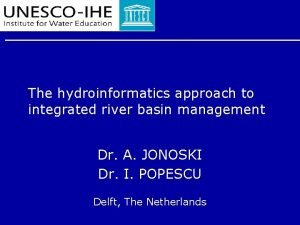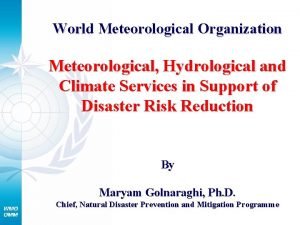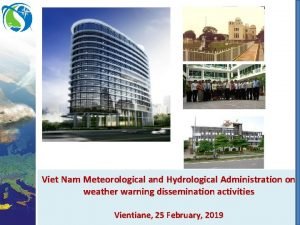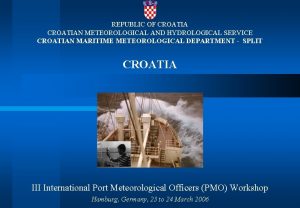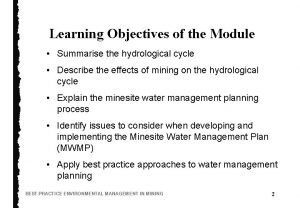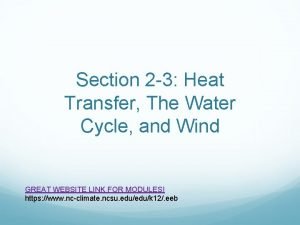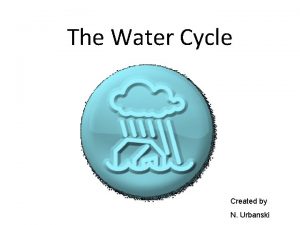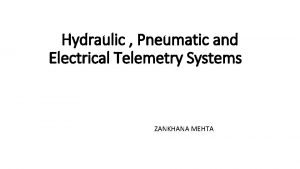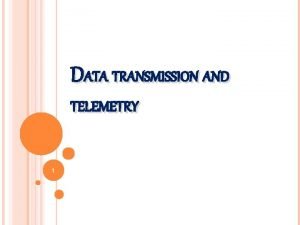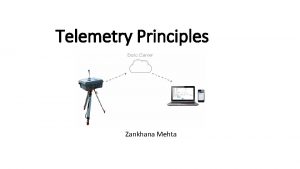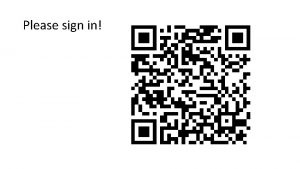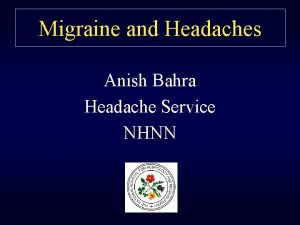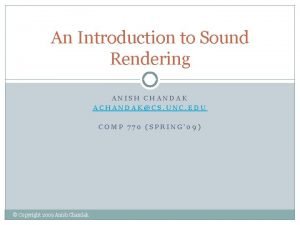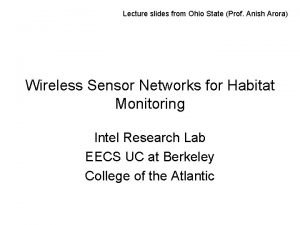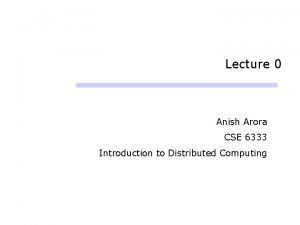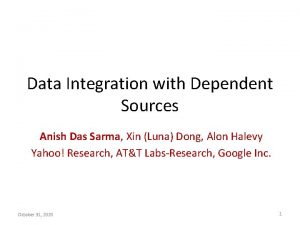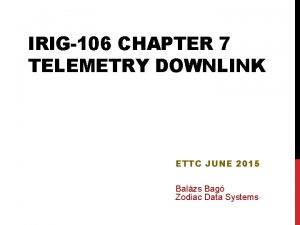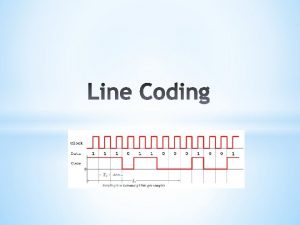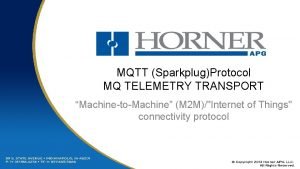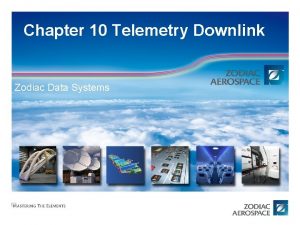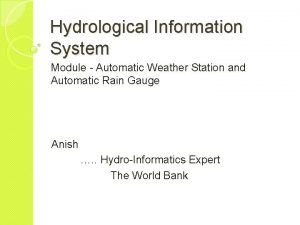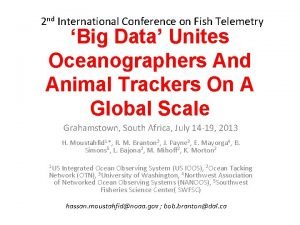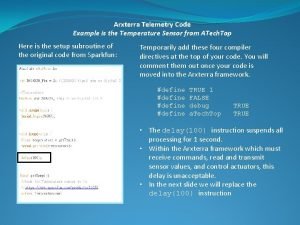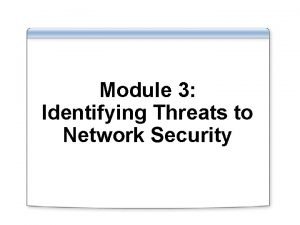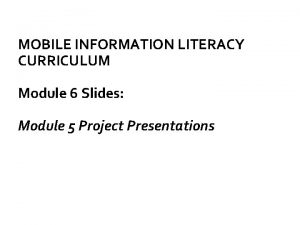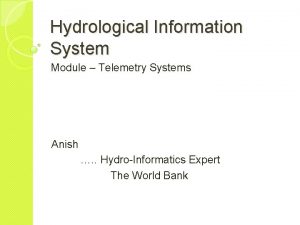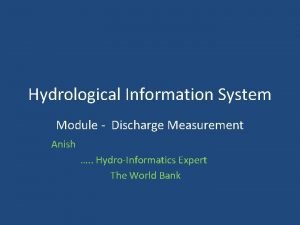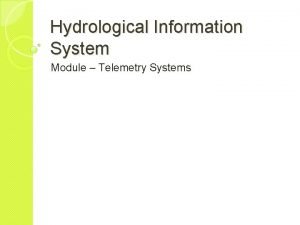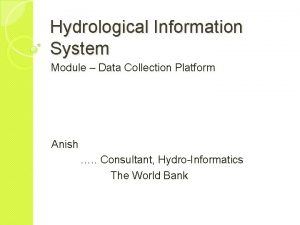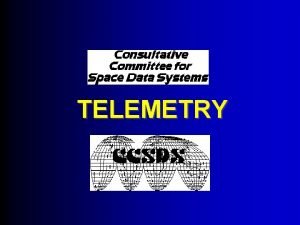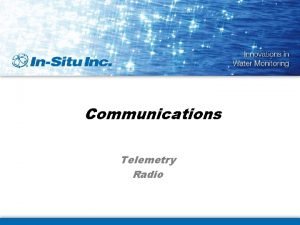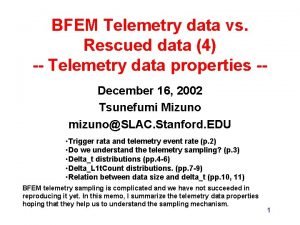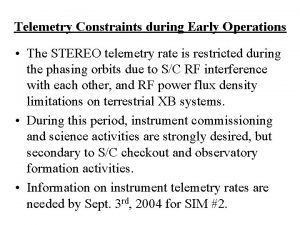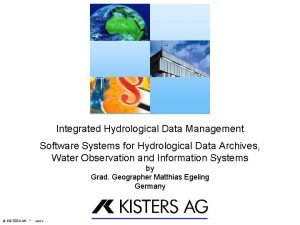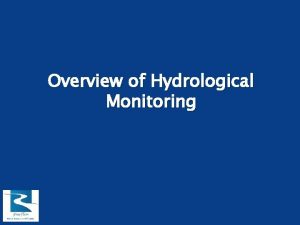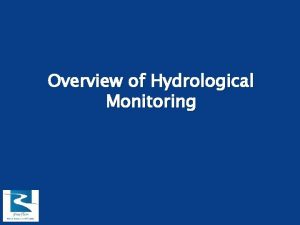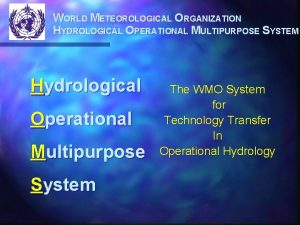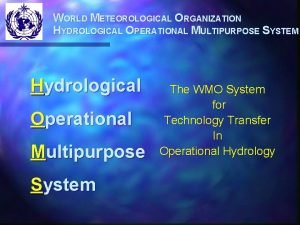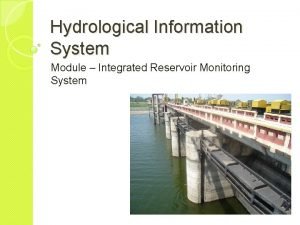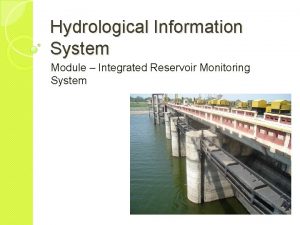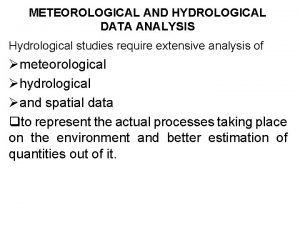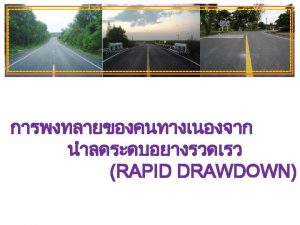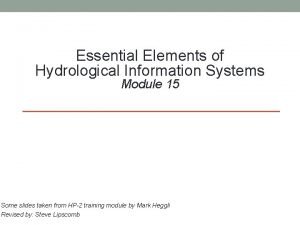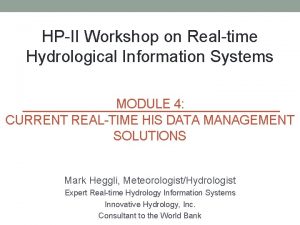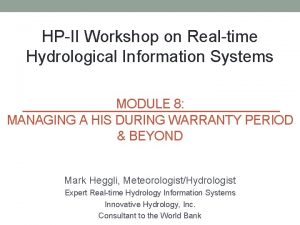Hydrological Information System Module Telemetry Systems Anish HydroInformatics







































- Slides: 39

Hydrological Information System Module – Telemetry Systems Anish …. . Hydro-Informatics Expert The World Bank

Module Contents �Communication Options �Earth Receiving Station �Transmitter Specification �ERS Specifications

Telemetry � Data logger to Control Room ◦ Earth based Communication Introduction �GSM / GPRS ◦ Satellite Based Communication �INSAT �VSAT

GSM Communication GSM/GPRS • Concept • GSM/GPRS systems can work by sending text messages and/or data files • Allows two-way communication, with the ability to change program settings, download data, or just query for the most recent measurements. Internet Decision Support Center

GSM Communication GSM/GPRS General Information Transmission: • • 900 MHz and 1. 8 GHz • Regulation: • Open for public use. Just need service agreement with mobile network provider • The Coverage • Makes GSM telecommunication a popular choice though there are several very important factors a hydrologic system operator must consider when choosing a telecommunication medium to relay hydrologic data • GSM/GPRS network is shared with the public • Real-time hydrologic systems that can miss periods of data collection, such as ground water, measurement, which is fairly static over time, are more suitable candidates to employ GSM/GPRS based technology GSM Coverage in India (taken from GSM World Coverage 2009)

GSM Communication GSM General Information Mobile Service Provider Tower

GSM - GPRS General Information �No Master control Room or ground station needed �Cloud based computing and data is made available on web

GSM Communication GSM/GPRS – Reception Window

GSM Communication Advantages/Disadvantages of GSM/GPRS Advantages • Coverage widely available in India • Quickest technology to implement, requiring only a service from mobile network provider • Relatively inexpensive • Disadvantages • Unreliable for public safety requirements such as flood warning and emergency management (Mobile network is a “best effort” technology) • Likelihood is great the GSM/GPRS bandwidth could be consumed by the public during public emergency. • • Can have high latency, especially Text Messaging

INSAT Communication Satellite-based solutions: INSAT �Concept ◦ Operated by the government of India to provide support to real-time environmental monitoring ◦ Well suited for remote hydrometric data collection as well as data sharing. Data sharing is implicit in the method that INSAT employs to collect and relay data �Anyone in view of the satellite can collect all hydrometric data, including data collected by IMD and CWC, who recently have modernized their networks with capabilities of real-time data collection

Data Transmission from Remote Stations INSAT Communication Satellite-based solutions: INSAT Raw Data Module Data Transmission through satellite Data Decoding Module Earth Receiving Station DAS Server Database / Backup Server

INSAT Communication Satellite-based solutions: INSAT Data Decoding Module Raw Data Module DAS Server Dish on Rooftop Database and backup Server

INSAT Communication Advantages/Disadvantages of INSAT � Advantages ◦ One of the great advantages of INSAT is that communication is possible from virtually anywhere in India ◦ Satellite is not affected by local weather events that can often disrupt terrestrial-based communications, such as GSM/GPRS. ◦ High reliability and implicit data sharing ◦ Operates on very low power ◦ Low running cost � Disadvantages ◦ ◦ WPC clearances and Licenses fee required One way communication Radios are more expensive than GSM Requires a ground station

VSAT Communication Satellite-based solutions: VSAT �Concept ◦ Privatively owned companies ◦ Bi-directional communication ◦ Complete Internet Solution (through satellite) ◦ Direct communication, though in some cases ground hops may exist ◦ Well suited for SCADA, which requires bidirectional communication

VSAT Communication Satellite-based solutions: VSAT

VSAT Communication Satellite-based solutions: VSAT Remote Station Server Room

VSAT Communication VSAT – Closer Look

VSAT Communication VSAT – Reception Window

VSAT Communication VSAT Power Consumption VSAT Communication needs much higher power, so size of Solar panels and Battery backup goes up

VSAT Communication Advantages/Disadvantages of VSAT �Advantages ◦ High reliability (if using Direct Connection) ◦ Bi-directional communication suitable for SCADA and interaction with data station (reprogramming) ◦ Radio licensing fees assumed by VSAT provider ◦ Used by banks and other institutions that require high availability �Disadvantages ◦ Large antenna/dish ◦ Uses more power than one-way devices ◦ High recurring cost (though this can be minimized with proper integration)

Communication Options Factors in Deciding a Best Fit in Data Communication �Factors ◦ ◦ ◦ ◦ Data Loss Cost (initial purchase) Recurring cost (Use Fee) Maintenance Privacy Sustainability Suitability for Flood Forecasting and SCADAs

Communication Options Telemetry - Comparison Factor GSM/GPRS INSAT VSAT Data Loss Medium Low Data Centre Establishment Cost Low High Low Cost (Initial) Low High Suitability for Flood Forecasting Low Medium High Recurring Cost Low High Medium Government Permission Required No Yes No Communication Direction 1 -Way 2 -Way

Earth Receive Station (ERS) �Every real-time HIS network will need a Earth Receive Station at a Data Center to receive data from the remote stations automatically. An Earth Receive Station (ERS) is also referred to as a Base Station (BS) or Ground Receive Station (GRS) �The ERS will utilize a dedicated server for the collection of data in real-time so that no other processes interfere with the collection of data to be provided by the

Earth Receive Station Typical Data Receive System

ransmitter pecifications INSAT Transmitter � INSAT Radio System to be Used on the INSAT Satellite operated by ISRO � Required to transmit on all series of INSAT satellites � Certificate of acceptance required by ISRO and/or IMD as part of the bid package � Demonstrated use of the satellite radio with at least 200 radios in current operation in India using INSAT � All associated equipment, including GPS, GPS Antenna, INSAT Antenna, all cables and mounting hardware � Antenna cable to be of high grade, LMR 400 or better � Temperature: Operating -40 to 60 C

ransmitter pecifications VSAT Transceiver � VSAT Radio system to allow two-way communication system between Data Center and remote station � VSAT communication will be direct link, and use the internet or any surface based topology for data communication (i. e. leased lines) � VSAT bandwidth will be able to be shared among all transmitters � VSAT remote stations shall be able to transmit based on alarm conditions at the remote site such as critical water level or exceptional precipitation events � All associated equipment, including Antenna all cables and mounting hardware � Antenna cable to be of high grade, LMR 400 or better � Temperature: Operating -40 to +60 C

ransmitter pecifications GSM/GPRS Transmitter � Utilize GPRS network for two-way TCP/IP (INTERNET) connection � Radio to utilize VPN protocol � Data collection to be triggered by interrogation from Data Center, or by event based transmission triggered by remote site � Ability to disable interrogation system in order to save power at remote site � Data transmission to execute HTTP Post or FTPS to transmit data to the Data Center � All associated equipment, including Antenna all cables and mounting hardware � Temperature: Operating +40 to 60 C

RS pecifications ERS General Requirements �A computer server (rack mount) is required to process the incoming data. Processing includes but is not limited to: ◦ Quality Control Checks and Rejection of Bad Data ◦ Alarms based on malfunctioning remote stations ◦ Provision to relay data to data base and/or applications server �The computer server is required to come equipped with all server accessories, such as UPS, router, computer rack, computer rails, electrical power supply

RS pecifications ERS Server General Requirements � � � A computer server (rack mount) is required to process the incoming data. All of the following specifications are minimum specifications. The Bidder will increase these specifications as required to support the Bidders Software and Hardware Solution CPU – Pentium IV 3. 0 GHz Memory – 16 GB Hard Disk – Capable of storing raw data for 500 stations for 10 years or a minimum of 1 TB. Hard Disk will be configured as RAID 1 with hardware controller, which means the Disk space will be effectively doubled Monitors – Three computer screens (server is required to have necessary hardware to support all three screen). Screens minimum 21”, flat screen. Wireless Keyboard and Mouse Optical Drives – CD/DVD RW+ Network – Two network adapters 10/1000 Mbps (RJ 45) Ports – Serial, parallel, 4 -USB Electrical – Supply voltage: 230 V nominal Operating System – Windows Server 2010, or most current.

RS pecifications ERS Server Software General Requirements � Software for decoding remote station data, and routing this data from the ERS to other computer nodes (i. e. FTPs, HTTP POST, and/or shared drive) � Diagnostic software: ◦ Station/sensor malfunction/outage, with automatic report generation and alarm protocol ◦ Received Signal Strength (if applicable) � Storage of all Raw Data on non-proprietary data base, and non-proprietary data base structure (i. e. Post. Gre. SQL, My. SQL) � Graphical and tabular viewing software, with user selectable stations and time period (up to one year)

RS pecifications INSAT ERS � System Characteristics: ◦ Required to collect all INSAT transmissions (IMD, CWC, SASE, etc. ), regardless of transmitter manufacturer or transmit format ◦ Overall data collection system performance better than 99. 9% error free data (Receiver must collect all data successfully transmitted from any remote station transmitting through INSAT) � INSAT 3. 8 m (minimum) receive dish capable of receiving data from remote stations according to performance standards set forth above. � Receiver, antenna, cabling, and all other accessories necessary to have a fully functional and reliable ERS � Front panel indicators on receiver for signal acquisition, channel activity and diagnostics

RS pecifications INSAT ERS Continued � INSAT Receive Dish System ◦ Appropriate size to assure collection of ALL data from remote stations ◦ Antenna Pedestal Type – Fixed EL/AZ antenna mount ◦ Wind Speed Operational Survival – 140 km/h or higher ◦ Lightning protection on all coaxial cables entering the building, as well as on all power feeds. Grounding will utilize Single Point Grounding Technique � C-Band LNB ◦ As required for successfully receiving 99. 9% of all data transmitted through INSAT � Receiver ◦ As required for receiving 99. 9% of all data transmitted through INSAT

RS pecifications VSAT Earth Station Specification � An VSAT System requires the ERS to receive transmissions directly from the VSAT satellite, and not data which is relayed through the Internet � System Characteristics: ◦ Overall data collection system performance better than 99. 9% error free data (Receiver must collect all data successfully transmitted from any remote station transmitting through VSAT) � VSAT receive dish capable of receiving data from remote stations according to performance standards set forth above. � Receiver/modem, antenna, cabling, and all other accessories necessary to have a fully functional and reliable ERS � Front panel indicators on receiver for signal acquisition, channel activity and diagnostics.

RS pecifications GSM/GPRS Earth Station Specification �A GPRS Earth Station receives GPRS data through the Internet, as there is no direct method of data collection such as that possible on INSAT and VSAT �A GPRS System requires a highly reliable Internet connection to receive data being relayed through the mobile network �There are no receivers required as transmissions will arrive by way of the Internet

ensor ommunication Sensor Communication Challenges �A site has no line of sight for Satellite and no GSM Coverage �Sensor very far from data logger �Other areas where using cable is prohibitive ◦ River Crossing ◦ Reservoir Structure (Pool elevation, river release, etc. )

Sensor Communication Challenges ensor ommunication Steep Valley, Satellite Line of Site not Available Need to Monitor Reservoir Water Level, Power House in Valley

ensor ommunication Solution ? Radio Pair � Slave Equipment connected to Sensor � Master Equipment Connected to Data Logger � Range varies by model, cheaper ones up to 2 KM, and some available for up to 50 KM Wireless Radio Slave

ensor ommunication Wireless Sensor Communication �Preferable Choice when: ◦ GSM coverage or Satellite line of sight available at other nearby location but not available at Water Level Site ◦ It is more economical to club multiple nearby stations to save datalogger and telemetry costs

ensor ommunication Advanced Sensor Communications �Wireless Sensor Communication ◦ Effective in combining sensors ◦ Saves cost of data logger/transmitter ◦ Effective in reducing long wire runs, or providing data collection where running wire is not feasible or possible ◦ Utilizes low power spread spectrum transmission frequency (similar to that used by portable phones) ◦ Operates on very low power at 12/24/48 Volts
 Hydroinformatics
Hydroinformatics National meteorological and hydrological services
National meteorological and hydrological services Vietnam meteorological and hydrological administration
Vietnam meteorological and hydrological administration Croatian meteorological and hydrological service
Croatian meteorological and hydrological service Hydrological
Hydrological Water cycle heat transfer
Water cycle heat transfer Diagram of hydrological cycle
Diagram of hydrological cycle Hydrological prediction center
Hydrological prediction center Pneumatic telemetry system
Pneumatic telemetry system Telemetry system
Telemetry system Block diagram of telemetry system
Block diagram of telemetry system Anish gonchigar
Anish gonchigar Anish arora osu
Anish arora osu Anish bahra
Anish bahra Anish chandak
Anish chandak Anish das sarma
Anish das sarma Anish arora osu
Anish arora osu Nagpal surgery
Nagpal surgery Anish arora
Anish arora Brian mathur
Brian mathur Anish das sarma
Anish das sarma C device module module 1
C device module module 1 Irig telemetry receiver
Irig telemetry receiver Telemetry signals
Telemetry signals Streaming telemetry data
Streaming telemetry data Silicon controls
Silicon controls Spark plug mqtt
Spark plug mqtt Irig 106 chapter 10
Irig 106 chapter 10 Merlin telemetry
Merlin telemetry Telemetry sim card
Telemetry sim card International conference on fish telemetry
International conference on fish telemetry Block telemetry
Block telemetry Module 10 drivers ed virginia
Module 10 drivers ed virginia Module 4 operating systems and file management
Module 4 operating systems and file management Differences between nervous system and endocrine
Differences between nervous system and endocrine Module 3: information and network security
Module 3: information and network security Media and information literacy module 6
Media and information literacy module 6 Decision support systems and intelligent systems
Decision support systems and intelligent systems Engineering elegant systems: theory of systems engineering
Engineering elegant systems: theory of systems engineering Embedded systems vs cyber physical systems
Embedded systems vs cyber physical systems
